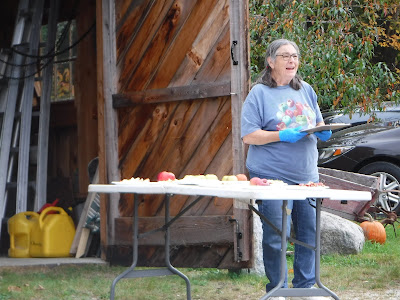I recently attended a fantastic program on apple diversity hosted by Eleanor Jenkins' Uplands Apple Farm in Eaton NH, led by Jared Kane, Executive Director, Branch Hill Farm Preservation Orchard, Milton Mills, NH with support from Catherine Dufault, District Manager, Carroll County Conservation District in Conway NH.
It was not quite the raucous crowd depicted in a print by Winslow Homer below (more on that later).
After a welcome and history of the orchard from Eleanor, Jared explained the history and taste profiles of each variety as we passed the plates around ...
... and enjoyed the beautiful views with heirloom apple trees planted all along the stone walls. We tried over fifteen varieties of apples (for our previous blog on Ashmead's Kernel follow this link here).
We were able to compare the taste with the unique look of the apples side by side. The chalk board in the cider room indicated it was a pretty good harvest this year.
The numbers next to the apple variety names indicates the number of bushels harvested. For more on this year's harvest and local apple history see this issue of the Conway Daily Sun here.
Now to the Winslow Homer print I mentioned above. It was published in Harper's Weekly Magazine in 1859. For more info on the print itself in various museum collections see these links here.
During the period the term "bee" referred to a social activity where work and play were combined. Other examples are the quilting bee, husking bee and scutching bee. Think of the insect bees and how they dance while they work.
The print includes numerous vignettes that provide several sets of interesting comparisons and contrasts to explore.
Let's start with the top of the image. Hung along the ceiling are several strings of sliced apples drying over the fireplace.
Drying apples preserved food calories in a time before refrigeration. Today we can get fresh apples from around the globe any time of the year. They could not.
Speed and productivity do not seem to be the main concern of the young couple depicted here. They may be more interested in the lingering and longing of courting. Compare the the pile of apples yet to do at their feet with the processed pile seen before. Also note the successful courting of the couples in the back ground behind them.
... who tosses an apple peel over her shoulder with the belief that it will spell out the initials of person she is destined to marry. For more on this tradition see the links here and here.
Seen below the young man working the mechanical peeler/parer (and the old folks watching him work) are a pair of children playing with a carved pumpkin.
Dried apple slices were (and are) a tasty snack that could be enjoyed as well as the main ingredient in New England's famous dried apple pie (for breakfast with sharp cheddar cheese). For our previous blogs on that tradition see these links here and here.
On the left section of the print a young man demonstrates an example of technological innovation to a group of older folks who look on attentively and somewhat bemused.
Here is a copy of an ad from 1895.
This machine peels and cores at the same time resulting in both labor saving and an increase in productivity. Notice the pile of processed apples on the table. You can still purchase essentially the same design today.
Also note the "White Mountain" potato parer (click on images to enlarge them).
They were made in a wide variety of styles. We have a number of versions in the collection of the Conway Historical Society. For more on the topic see the Virtual Apple Parer Museum here.
On the right of the print can be seen the more traditional hand peeling method.
More romance can be seen in the central figure...
Almost obscured in the background is a liquid contrast to the solid examples of apple products. This vignette is but a small portion of the print, however, as Jared explained during the program, this apple product played the largest role in the actual history of apples in this country before the 18th Amendment to the U.S. Constitution (Prohibition).
A nicely dressed older gentleman raises a glass of cider poured from a barrel seen over his left shoulder. Jared explained that "cider" refers specifically to the alcoholic drink and therefore the term hard cider is redundant.
David Tatham here (p. 87) points out how unique this print is in Homer's body of work. He argues that "Nothing in his work as a painter remotely recalls the electric, hot-blooded relations among young men and women that he recorded with such evident relish in these country frolics. In hardly any other of his drawings for the pictorial press did he depict such free and unselfconscious displays of emotion between individuals."
For a taste of more on the autumn harvest see our current display at the Conway Public Library and its related blog here.
To further explore this and many other historical topics, we offer free outreach programs to local schools and community groups. We can also provide programs via zoom. Please contact us at the Conway Public Library's Henney History Room for more information.














No comments:
Post a Comment